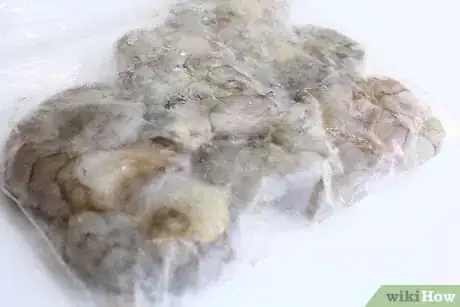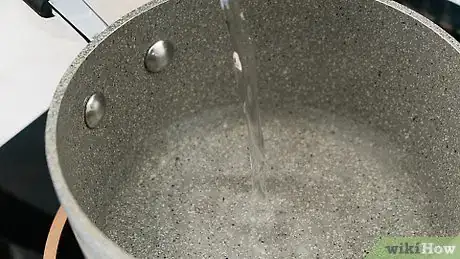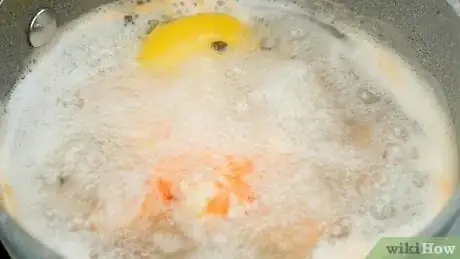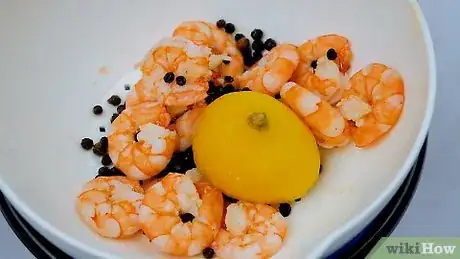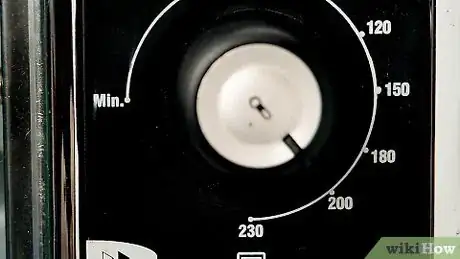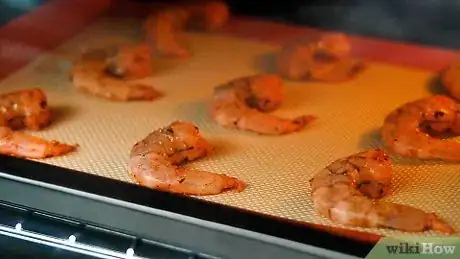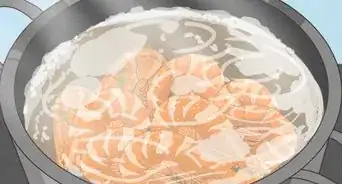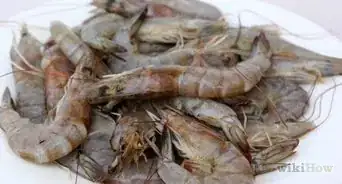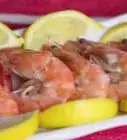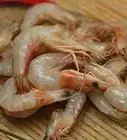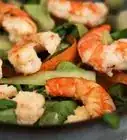This article was co-authored by Jennifer Lease, RD, CDN. Jennifer Lease is a Registered Dietitian and Trained Chef based in Denver, Colorado. With six years of experience in the food and nutrition fields, she specializes in a plant-forward approach to applying nutrition information to cooking. Jennifer holds a BS in Dietetics and a Dietetic Internship Certificate from The University of Delaware. She also received her professional chef training from The Natural Gourmet Institute for Health and Culinary Arts.
There are 24 references cited in this article, which can be found at the bottom of the page.
This article has been viewed 186,679 times.
A bag of frozen shrimp can be a lifesaver come dinnertime. If not properly prepared, however, your favorite seafood dishes can easily turn into a bland, watery mess. The key to cooking with frozen shrimp is to give them plenty of time to thaw before combining them with other ingredients. Once all the excess liquid has been released, you can throw your shrimp into a pot of boiling water, sizzling skillet, or preheated oven and cook them to perfection.
Steps
Thawing
-
1Pick up a bag of peeled, deveined shrimp. Starting with shrimp that have already been peeled and deveined will help you cut down on your prep time. If you prefer, you can also buy whole shrimp and peel them yourself later. Either way, all you’ll have to do to get them ready for the pot, oven, or skillet is thaw them out.[1]
- While shopping for frozen shrimp, check each package for a symbol reading “IQF,” which stands for “Individually Quick Frozen.” This means each shrimp has been frozen separately, which reduces clumping and improves flavor and texture.
- It’s important that your shrimp be deveined. It’s practically impossible to devein shrimp while they’re still frozen or after they’ve been cooked, and it will take much longer if you wait until after they’ve thawed.[2]
-
2Place the shrimp in a colander or wire strainer. Snip open the bag and shake out the frozen shrimp into your colander or strainer. To ensure that your shrimp defrost as quickly as possible, be sure to break up any large chunks that have frozen together.[3]
- If you don’t have a colander or strainer, try leaving the bag sealed and running some cool water over it in the sink to thaw it. It’s time-consuming, but it will get the job done.
- You can also place the exact amount of shrimp you want to cook in a separate resealable plastic bag before continuing if you don't want to prepare the entire bag at once.
Advertisement -
3Submerge the colander or strainer in a bowl of cool water. Lower the colander into the bowl, making sure it fits comfortably and the water covers the shrimp entirely. Allow the shrimp to sit for 10-15 minutes, or until the last of the ice has melted.[4]
- To speed up the thawing process, leave a small stream of fresh water trickling into the bowl to continually replace the water that’s grown cold.[5]
Warning: Never use warm water to defrost frozen shrimp. This can cause it to thaw unevenly, which can impact its texture.
-
4Transfer the thawed shrimp to a layer of folded paper towels. Remove the colander or strainer and shake it a few times to get rid of excess water, then pour the shrimp out on top of the paper towels. Fold one half of the absorbent pad over or use a separate towel to gently blot the shrimp and soak up any remaining moisture.[6]
- There should be no visible ice crystals or standing water on the surface of the shrimp when you’re done.
-
5Heat the shrimp briefly to release any remaining liquid (optional). Add your thawed shrimp to a dry nonstick pan or pot of boiling water over high heat and cook them for roughly 2-3 minutes, or until they just turn opaque. The heat will cause the shrimp to shrink slightly, essentially wringing every last bit of unwanted moisture out of them.[7]
- While it’s not necessary to give your shrimp a preliminary warmup, it can be a useful step if you want to make sure they don’t make the dish you’re preparing soggy.
Boiling
-
1Fill a large pot 3/4 of the way up with water. Leave 1–2 inches (2.5–5.1 cm) at the top of the pot to give the water plenty of room to rise as it reaches a boil. Be sure to choose a piece of cookware that’s roomy enough to hold all the shrimp you plan on cooking, along with your water. Your shrimp shouldn't take up more than about 1/4 of the pot's total volume.[8]
- To save yourself some time, let your tap run until it’s as hot as it can get before you begin filling your pot to increase the starting temperature of your water.
- If you boiled your frozen shrimp to finish thawing them, you can skip straight to cooking them in the same water.
-
2Bring your water to a high boil. Position the pot on one of your stove’s central burners and turn it on to medium-high heat. When the water begins to bubble steadily, it will be time to put in your shrimp.[9]
- Adding the shrimp before your water reaches a boil can lower its temperature, causing the shrimp to take longer to cook and leaving it rubbery as a result.
-
3Add whole spices and other flavorings to your cooking liquid (optional). Sprinkle a generous amount of kosher salt into your pot to help season the shrimp. Then, throw in any other ingredients you want to use. For 1⁄2 pound (230 g) of shrimp, you might include 2-3 teaspoons (10-14 g) of cloves or peppercorns, or squeeze and drop in half of a lemon.[10]
- Fresh herbs like parsley, thyme, or cilantro can also be used to impart zesty, pungent, and savory notes.
- Let your flavorings simmer for about 5 minutes in order to bring out their full flavor.
-
4Boil your shrimp for 2-7 minutes, or until they begin to float. Smaller shrimp will typically only need to cook for 2-3 minutes, while larger ones may need closer to 5. Watch closely for a few shrimp to begin bobbing to the surface of the pot—this is a good sign that they’re done.[11]
- Stir your shrimp periodically as they boil to make sure they all heat evenly.
- There's no need to wait for all of your shrimp to float. Once you notice a half a dozen or so pop up, it will be safe to take them off the stove.
Tip: Perfectly boiled shrimp will be plump, juicy, and light pink in color.
-
5Drain your boiled shrimp thoroughly in a colander or wire strainer. Switch off the stove and use a pair of potholders or oven mitts to carefully lift the pot off of the burner. Pour the shrimp out into your colander or strainer, then give it a couple shakes to remove excess water.[12]
- If you’re making shrimp cocktail or plan on reheating your shrimp later, plunge them into an ice bath for a few seconds, then drain them again. This will prevent them from overcooking accidentally.[13]
- For maximum flavor, serve your boiled shrimp hot with melted butter and a dash of Old Bay Seasoning.
- If you end up with uneaten shrimp, transfer them to an airtight storage container and stick them in the refrigerator. They should keep for up to 3 days.[14]
Broiling in Oven
-
1Preheat your oven’s broiler. Set the broiler to high heat and give it at least 8-10 minutes to reach its top temperature—it needs to be nice and hot in order to give your shrimp a perfect crispy exterior. While it’s warming up, you can finish getting your shrimp ready.[15]
- You can also use a conventional bake or convection setting at around 400 °F (204 °C), though broiling your shrimp will improve their texture and help them cook faster.[16]
-
2Toss your shrimp in dry spices for a burst of added flavor. Mix up a quick seasoning blend using 3/4 of a teaspoon of kosher salt, 1/2 of a teaspoon of garlic powder and paprika, and 1/4 of a teaspoon each of cracked black pepper, cayenne pepper, and oregano. Stir your spices together in a large mixing bowl, then add your shrimp and toss them until they’re evenly coated.[17]
- Lemon pepper is another popular seasoning choice for broiled shrimp and similar seafood dishes.
- The quantities of spices listed here should be just right for about 1⁄2 pound (230 g) of shrimp. If you're preparing more or less, adjust your proportions accordingly.
Tip: If you like, you can also top your seasoned shrimp with butter prior to broiling them for an irresistibly smooth and delectable finish.[18]
-
3Spread out your thawed shrimp on a nonstick baking sheet. Arrange the shrimp in a single layer so that there’s about 1⁄2 in (1.3 cm) of space between each. Make sure none of them are covering or overlapping the others.[19]
- Giving your shrimp some room to breathe will help them cook faster and more consistently.
- Use a baking sheet or broiler pan with raised edges to prevent the shrimp from sliding off.
-
4Broil the shrimp for 5-8 minutes, or to the desired doneness. Slide the pan onto the upper rack of your oven directly beneath the broiler, then close the door. Your shrimp won’t take long at all to cook through, especially under the intense heat of the broiler.[20]
- You’ll know your shrimp are done when they turn a pale pink color, with a small amount of visible browning around the edges.[21]
- If your oven has a light inside, switch it on so you can keep an eye on your shrimp as they cook.
-
5Remove your shrimp safely from the oven using an oven mitt. Once your shrimp are done, open the oven, reach inside, and carefully take hold of the baking sheet. Rest the baking sheet on a nearby stove, countertop, or other heat safe surface to cool.
- Allow your shrimp to cool for 2-3 minutes before serving them up. Avoid handling the baking sheet in the meantime, as it will be extremely hot.
- Place your leftovers in an airtight container and put them in the refrigerator, where they'll stay fresh for about 3 days.[22]
Sautéing
-
1Heat 1–2 tablespoons (15–30 mL) of oil or butter in a large skillet. Tilt the skillet in all different directions as it warms up to make sure your cooking surface is evenly coated. Wait for the oil to begin shimmering slightly before adding your shrimp.[23]
- For best results, choose an oil with a high smoke point, such as vegetable, canola, peanut, or sunflower oil.[24] Olive oil works great for this!
- Be careful not to let your skillet get too hot, especially if you’re using butter. Doing so could cause your cooking fat to scorch, resulting in a burnt, acrid taste.
- You'll have the easiest time sautéing 1⁄4–1⁄2 pound (110–230 g) of shrimp at a time.
-
2Add garlic or other aromatics to your oil for additional flavor. If you like, you can throw 1⁄2–1 ounce (14–28 g) of minced garlic, sliced white onion, chopped parsley or shallots, or lemon zest into your skillet as it heats up. Cook your chosen ingredients until they just begin to soften and turn translucent.[25]
- Be careful not to overcook your aromatics, or they could cause your shrimp to taste burnt. They’ll most likely only need about 30-45 seconds in the skillet.
Tip: Aromatics like garlic and shallots can lend a whole new dimension of deliciousness to your sautéed shrimp.
-
3Add your shrimp to the skillet and sauté them for 4-5 minutes. They’ll begin sizzling as soon as they touch the hot cooking surface. Keep the pan moving or stir the shrimp constantly to make sure they heat evenly. In a few short minutes, your shrimp will take on a soft pinkish-white color and a slightly crispy outer texture.[26]
- Feel free to dust your shrimp with about 1/2 of a teaspoon each of salt, pepper, chili powder, curry spice, and cayenne pepper at this point, or season them to your own personal taste.[27]
- Shrimp cook quickly, so make sure you don’t walk away and leave the skillet unattended, or they could burn.
-
4Let your shrimp cool for 1-2 minutes before eating them. The shrimp will be hot when they first come out of the skillet. As difficult as it may be, try to hold off on eating them until they’ve had time to cool to a safe temperature. Enjoy!
- Finish your sautéed shrimp with a drizzle of melted butter or a sprinkle of freshly-minced savory herbs, such as parsley, cilantro, or dill.[28]
- Refrigerate your leftovers in an airtight container and try to consume them within 2-3 days.
Community Q&A
-
QuestionI bought a packet of blanched and frozen small shrimp. I want to make a shrimp cocktail as a starter. How do I prepare the shrimp?
 Community AnswerFollow the instructions in Make Shrimp Cocktail .
Community AnswerFollow the instructions in Make Shrimp Cocktail . -
QuestionHow do I steam frozen shrimp that already been peeled and is the color pink?
 Community AnswerThaw the shrimp first in cold water. Get the water boiling and producing steam in your steamer before adding the shrimp. Let steam only a minute or less, as steaming will greatly toughen the shrimp meat.
Community AnswerThaw the shrimp first in cold water. Get the water boiling and producing steam in your steamer before adding the shrimp. Let steam only a minute or less, as steaming will greatly toughen the shrimp meat. -
QuestionIs it OK to cook frozen shrimp?
 Drew Hawkins1Community AnswerAbsolutely! As long as the shrimp were frozen correctly, they're super easy to cook and add to a dish. Place them in a strainer or colander and submerge them into a bowl of cool water for about 15 minutes to thaw them out. Then, just cook them like you would fresh shrimp.
Drew Hawkins1Community AnswerAbsolutely! As long as the shrimp were frozen correctly, they're super easy to cook and add to a dish. Place them in a strainer or colander and submerge them into a bowl of cool water for about 15 minutes to thaw them out. Then, just cook them like you would fresh shrimp.
Warnings
- It’s not safe to consume frozen shrimp (or any kind of shrimp, for that matter) if you suffer from a shellfish allergy.[30]⧼thumbs_response⧽
Things You’ll Need
Thawing Frozen Shrimp
- Colander or wire strainer
- Paper towels
- Nonstick pot or pan (optional)
Boiling Your Shrimp
- Large pot
- Wooden spoon
- Colander or wire strainer
- Potholders
- Large bowl for ice bath (optional)
Broiling Your Shrimp in the Oven
- Large mixing bowl
- Nonstick baking sheet or broiler pan
- Oven mitt
Sautéing Your Shrimp
- Large skillet
- Spoon or spatula
- Potholder
- Knife, grater, or zester (for preparing fresh herbs)
References
- ↑ https://www.thecitycook.com/articles/2014-08-06-frozen-shrimp-101
- ↑ https://cookthestory.com/how-to-cook-shrimp-from-frozen/
- ↑ https://www.finecooking.com/article/a-quick-way-to-thaw-shrimp
- ↑ http://www.melaniecooks.com/how-to-thaw-frozen-shrimp-fast/306/
- ↑ https://www.finecooking.com/article/a-quick-way-to-thaw-shrimp
- ↑ https://www.thecitycook.com/articles/2014-08-06-frozen-shrimp-101
- ↑ http://dish.allrecipes.com/this-easy-trick-makes-frozen-shrimp-taste-way-better-2/
- ↑ https://cookthestory.com/how-to-cook-shrimp-from-frozen/
- ↑ https://natashaskitchen.com/quick-and-easy-boiled-shrimp-recipe/
- ↑ https://www.myrecipes.com/how-to/how-to-boil-shrimp
- ↑ https://natashaskitchen.com/quick-and-easy-boiled-shrimp-recipe/
- ↑ https://addapinch.com/boiled-shrimp-recipe/
- ↑ https://www.thekitchn.com/how-to-make-a-perfect-shrimp-cocktail-240329
- ↑ https://www.thedailymeal.com/leftover-guide-how-long-can-you-keep-it
- ↑ https://www.geniuskitchen.com/recipe/broiled-shrimp-17658
- ↑ https://www.thekitchn.com/how-to-roast-shrimp-in-the-oven-cooking-lessons-from-the-kitchn-204080
- ↑ https://www.thekitchn.com/how-to-cook-frozen-shrimp-247331
- ↑ https://spicysouthernkitchen.com/buttery-broiled-shrimp/
- ↑ https://www.tasteslovely.com/perfect-every-time-lemon-garlic-shrimp/
- ↑ https://www.tasteofhome.com/recipes/broiled-buttery-shrimp/
- ↑ https://www.thekitchn.com/how-to-cook-frozen-shrimp-247331
- ↑ https://www.thedailymeal.com/leftover-guide-how-long-can-you-keep-it
- ↑ https://www.foodnetwork.com/recipes/sauteed-shrimp-recipe-1942539
- ↑ https://www.seriouseats.com/2014/05/cooking-fats-101-whats-a-smoke-point-and-why-does-it-matter.html
- ↑ https://www.youtube.com/watch?v=M4fVNtqIl5A&t=11s
- ↑ https://www.geniuskitchen.com/recipe/cajun-sauteed-shrimp-41701
- ↑ https://www.thekitchn.com/how-to-quickly-cook-shrimp-on-the-stovetop-cooking-lessons-from-the-kitchn-214397
- ↑ https://damndelicious.net/2014/04/11/garlic-butter-shrimp/
- ↑ http://www.eatbydate.com/proteins/seafood/how-long-does-shrimp-last/
- ↑ https://www.foodallergy.org/common-allergens/shellfish
About This Article
To cook frozen shrimp, first take the shrimp out of the bag and place them in a colander or strainer. Place the colander or strainer in a bowl filled with cool water and wait 10-15 minutes for the shrimp to thaw. Don’t use warm water since it can affect the shrimps’ texture. Once they’re thawed, transfer the shrimp to a paper towel and pat them dry. To boil the shrimp, bring a pot of water to a boil and cook the shrimp in it until they float to the surface of the water, which can take anywhere from 2 to 7 minutes depending on their size. Drain the shrimp in a colander and enjoy! You can also broil shrimp in the oven. Set the broiler to high heat, and toss the shrimp in some seasonings, like salt, pepper, garlic powder, and paprika. Spread them out on a nonstick baking sheet and broil them for 5-8 minutes. You’ll know they’re done when they turn a pale pink color with some browning on the edges. To learn how to broil shrimp in the oven, read on!
